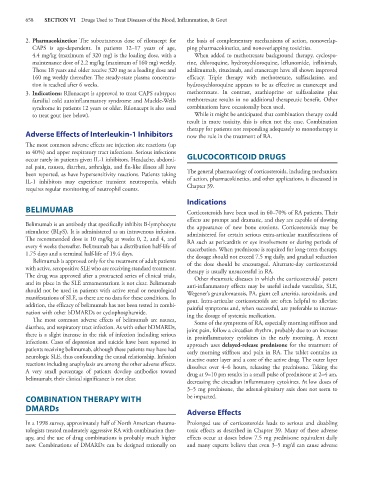Page 672 - Basic _ Clinical Pharmacology ( PDFDrive )
P. 672
658 SECTION VI Drugs Used to Treat Diseases of the Blood, Inflammation, & Gout
2. Pharmacokinetics: The subcutaneous dose of rilonacept for the basis of complementary mechanisms of action, nonoverlap-
CAPS is age-dependent. In patients 12–17 years of age, ping pharmacokinetics, and nonoverlapping toxicities.
4.4 mg/kg (maximum of 320 mg) is the loading dose, with a When added to methotrexate background therapy, cyclospo-
maintenance dose of 2.2 mg/kg (maximum of 160 mg) weekly. rine, chloroquine, hydroxychloroquine, leflunomide, infliximab,
Those 18 years and older receive 320 mg as a loading dose and adalimumab, rituximab, and etanercept have all shown improved
160 mg weekly thereafter. The steady-state plasma concentra- efficacy. Triple therapy with methotrexate, sulfasalazine, and
tion is reached after 6 weeks. hydroxychloroquine appears to be as effective as etanercept and
3. Indications: Rilonacept is approved to treat CAPS subtypes: methotrexate. In contrast, azathioprine or sulfasalazine plus
familial cold autoinflammatory syndrome and Muckle-Wells methotrexate results in no additional therapeutic benefit. Other
syndrome in patients 12 years or older. Rilonacept is also used combinations have occasionally been used.
to treat gout (see below). While it might be anticipated that combination therapy could
result in more toxicity, this is often not the case. Combination
therapy for patients not responding adequately to monotherapy is
Adverse Effects of Interleukin-1 Inhibitors now the rule in the treatment of RA.
The most common adverse effects are injection site reactions (up
to 40%) and upper respiratory tract infections. Serious infections
occur rarely in patients given IL-1 inhibitors. Headache, abdomi- GLUCOCORTICOID DRUGS
nal pain, nausea, diarrhea, arthralgia, and flu-like illness all have
been reported, as have hypersensitivity reactions. Patients taking The general pharmacology of corticosteroids, including mechanism
IL-1 inhibitors may experience transient neutropenia, which of action, pharmacokinetics, and other applications, is discussed in
requires regular monitoring of neutrophil counts. Chapter 39.
Indications
BELIMUMAB Corticosteroids have been used in 60–70% of RA patients. Their
effects are prompt and dramatic, and they are capable of slowing
Belimumab is an antibody that specifically inhibits B-lymphocyte the appearance of new bone erosions. Corticosteroids may be
stimulator (BLyS). It is administered as an intravenous infusion. administered for certain serious extra-articular manifestations of
The recommended dose is 10 mg/kg at weeks 0, 2, and 4, and RA such as pericarditis or eye involvement or during periods of
every 4 weeks thereafter. Belimumab has a distribution half-life of exacerbation. When prednisone is required for long-term therapy,
1.75 days and a terminal half-life of 19.4 days. the dosage should not exceed 7.5 mg daily, and gradual reduction
Belimumab is approved only for the treatment of adult patients of the dose should be encouraged. Alternate-day corticosteroid
with active, seropositive SLE who are receiving standard treatment. therapy is usually unsuccessful in RA.
The drug was approved after a protracted series of clinical trials, Other rheumatic diseases in which the corticosteroids’ potent
and its place in the SLE armamentarium is not clear. Belimumab anti-inflammatory effects may be useful include vasculitis, SLE,
should not be used in patients with active renal or neurological Wegener’s granulomatosis, PA, giant cell arteritis, sarcoidosis, and
manifestations of SLE, as there are no data for these conditions. In gout. Intra-articular corticosteroids are often helpful to alleviate
addition, the efficacy of belimumab has not been tested in combi- painful symptoms and, when successful, are preferable to increas-
nation with other bDMARDs or cyclophosphamide. ing the dosage of systemic medication.
The most common adverse effects of belimumab are nausea, Some of the symptoms of RA, especially morning stiffness and
diarrhea, and respiratory tract infection. As with other bDMARDs, joint pain, follow a circadian rhythm, probably due to an increase
there is a slight increase in the risk of infection including serious in proinflammatory cytokines in the early morning. A recent
infections. Cases of depression and suicide have been reported in approach uses delayed-release prednisone for the treatment of
patients receiving belimumab, although these patients may have had early morning stiffness and pain in RA. The tablet contains an
neurologic SLE, thus confounding the causal relationship. Infusion inactive outer layer and a core of the active drug. The outer layer
reactions including anaphylaxis are among the other adverse effects. dissolves over 4–6 hours, releasing the prednisone. Taking the
A very small percentage of patients develop antibodies toward drug at 9–10 pm results in a small pulse of prednisone at 2–4 am,
belimumab; their clinical significance is not clear.
decreasing the circadian inflammatory cytokines. At low doses of
3–5 mg prednisone, the adrenal-pituitary axis does not seem to
COMBINATION THERAPY WITH be impacted.
DMARDs Adverse Effects
In a 1998 survey, approximately half of North American rheuma- Prolonged use of corticosteroids leads to serious and disabling
tologists treated moderately aggressive RA with combination ther- toxic effects as described in Chapter 39. Many of these adverse
apy, and the use of drug combinations is probably much higher effects occur at doses below 7.5 mg prednisone equivalent daily
now. Combinations of DMARDs can be designed rationally on and many experts believe that even 3–5 mg/d can cause adverse

